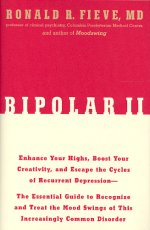|
Published by Rodale |
|
You are on fire. For a few days, you've stayed up late, woken up early, and accomplished your to-do list -- and then some. You've called friends you haven't talked to in ages, organized your closet, finished your project, danced until dawn, and still made it to work on time the next morning. Everyone and everything is great -- you love life! You've finally "made it," and you're feeling fantastic. Would you like to feel like this all the time? Who wouldn't? This buzz, this electric, ultra-positive feeling of focus and productivity is called hypomania, a key symptom of bipolar II, a subtype of the bipolar spectrum. Acclaimed author Dr. Ronald Fieve says millions of the most accomplished Americans enjoy just these types of highs on a regular basis. Many people with this condition never seek treatment for their subsequent lows because they treasure their highs and don't want to lose them. The danger is that undiagnosed Bipolar II has one of the highest rates of depression and suicide among all mental illnesses, because the lows can be so devastating. But Dr. Fieve wants to spread the word that Bipolar II can actually be beneficial, if diagnosed and treated. That's what drove Dr. Fieve, a world-renowned psychopharmacologist and bipolar researcher, to write Bipolar II, the first book exclusively focused on this little-understood condition. He wants to help people make the most of the highs -- and minimize, if not do away with entirely, the devastating lows. From his preface: "From the thousands of patients I have treated since the early 1970s, along with the major diagnostic changes of manic depression, I concluded that about half of my Bipolar II patients used their mild hypomanic highs to an advantage. I labeled this group of gifted people as Bipolar IIB (beneficial) and published a medical journal study on this topic in 1992. "Since then, I have learned so much more about what keeps patients feeling in top form and living highly productive lives. Throughout this book, I want to help you recognize the earliest signs of this increasingly diagnosed soft condition, Bipolar II, and teach you how to be proactive in preventing debilitating episodes. I want you and your family to see how early recognition of the signs and symptoms of mild to severe depression and hypomania (mild mania) will improve the prognosis for Bipolar II, so you can see your doctor immediately for effective treatment. Above all, I want to help you prevent the tormenting high and low moods that often arise with Bipolar II disorder. And with proper treatment and maintenance, you will be able to prevent them." pub date: 2006-10-03 | hardcover | 9781594862243 |
|


